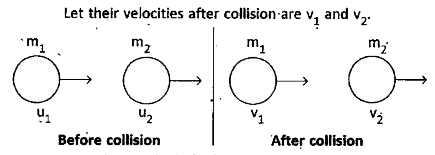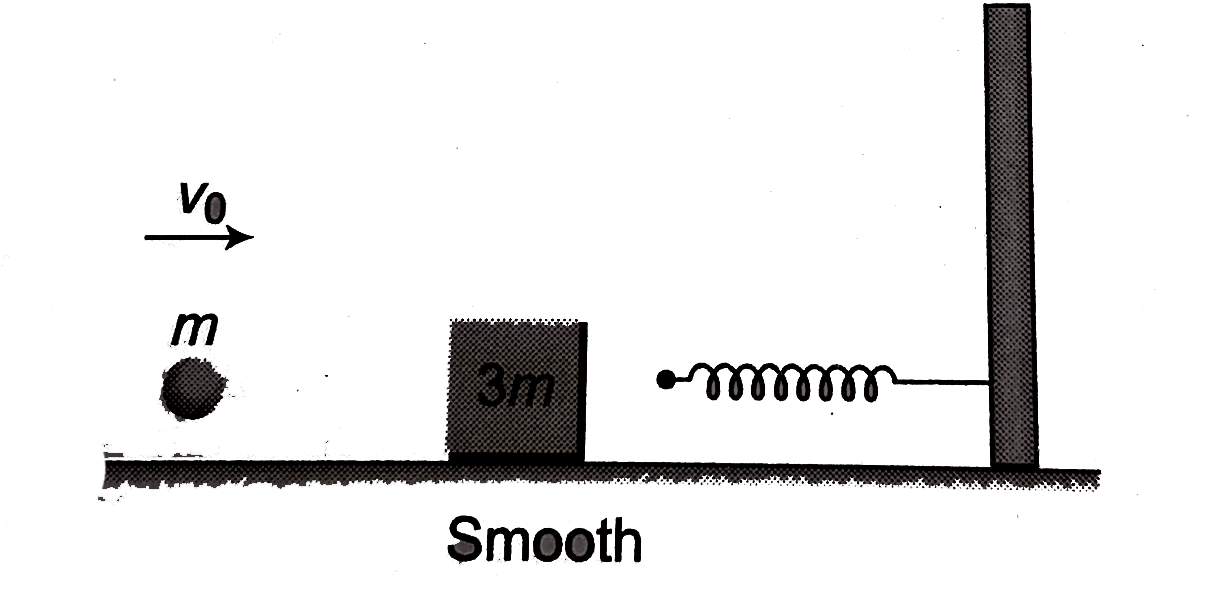What are collisions ? Explain the possible types of collisions ?
Develop the theory of one dimensional elastic collision.
To simulate car accidents, auto manufacturers study the collisions of moving cars with mounted springs of different spring constants. Consider a typical simulation with a car-of mass 1000 kg moving with a speed 18.0 km/h on a smooth road and colliding with a horizontally mounted spring of spring constant 6.25×103Nm−7. What is the maximum compression of the spring ?
A process in which the motion of a system of particles changes but keeping the total momentum conserved is called collision. Collisions are two types : 1) elastic 2) inelastic.
Velocities of two bodies after elastic collision :
Let two bodies of masses m1,m2 , are moving with velocities u1,u2 alono the came line in came direction collided elastically.

After collision According to the law of conservation of linear, momentum
m1u1+m2u2=m1v1+m2v2
or m1(u1−v1)=m2(v2−u2) .......(1)
According to the law of conservation of kinetic energy
12m1u21+12m2u22=12m1v21+12m2v22
m1(u21−v21)=m2(v22−u22) ....(2)
Dividing eqn. ( 2 ) by (1)
u21−v21u1−v1=v22−u22v2−u2 or u1+v1=v2+u2
u1−u2=v2−v1 ...(3)
i.e., In elastic collisions relative velocity of approach of the two bodies before collision = relative velocity of separation of the two bodies after collision.
To find v1, put v2=u1−u2+v1 in eqn. (1).
m2u1+m2u2=m1v1+m2(u1−u2+v1)
m1u1+m2u2=m1v1+m2u1−m2u2+m2v1
m1u1+m2u2−m2u1+m2u2=v1(m1+m2)
u1(m1−m2)+2m2u2=v1(m1+m2)
∴v1=m1−m2m1+m2u1+2m2m1+m2u2 ....(4)
Similarly, v2=u2(m2−m1)m1+m2+2m1u1m1+m2 .....(5)
Problem:
At maximum compression the kinetic energy of the car is converted entirely into the potential energy of the spring.
The kinetic energy of the moving car is
K=12mv2=12×103×5×5
K=1.25×104J
where we have converted 18km h−1 to 5ms−2 [It is useful to remember that 36km h−1=10ms−1].
At maximum compression Xm, the potential energy V of the spring is equal to the kinetic energy K of the moving car from the principle of conservation of mechanical energy.
V=12kx2m=1.25×104J
We obtain Xm=2.00m
We note that we have idealised the situation. The spring is considered to be massless. The surface has been considered to possess negligible friction.
Related Playlists
Similar Questions
To stimulat car accidents, the auto manufacturers study the collisions of moving cars with mounted springs of different spring constants. Consider a typical simulation with a car of mass 1000kg moving with a speed of 18.0km/h on a smooth road and colliding with a horizontally mounted spring of spring constant 6.25×103Nm−1. What is the maximum compression of the spring?
View SolutionTo stimulat car accidents, the auto manufacturers study the collisions of moving cars with mounted springs of different spring constants. Consider a typical simulation with a car of mass 1000kg moving with a speed of 18.0km/h on a smooth road and colliding with a horizontally mounted spring of spring constant 6.25×103Nm−1. What is the maximum compression of the spring?
View SolutionTo stimulat car accidents, the auto manufacturers study the collisions of moving cars with mounted springs of different spring constants. Consider a typical simulation with a car of mass 1000kg moving with a speed of 18.0km/h on a smooth road and colliding with a horizontally mounted spring of spring constant 6.25×103Nm−1. What is the maximum compression of the spring?
View SolutionA car of mass 1000 kg moving with a speed 18kmh−1 on a smooth road and colliding with a horizontally mounted spring of spring constant 6.25×103Nm−1. The maximum compression of the spring is
View SolutionA car of mass 1000 kg moving with a speed 18kmh−1 on a smooth road and colliding with a horizontally mounted spring of spring constant 6.25×103Nm−1. The maximum compression of the spring is
View SolutionAuto manufactures study the collision of cars with mounted spring of different spring constant. Consider a car of mass 1500 kg moving with a speed of 36kmh−1 on a smooth road and colliding with a horizontally mounted spring of spring constant 7.5×103Nm−1. Find the maximum compression of the spring .
View SolutionAuto manufactures study the collision of cars with mounted spring of different spring constant. Consider a car of mass 1500 kg moving with a speed of 36kmh−1 on a smooth road and colliding with a horizontally mounted spring of spring constant 7.5×103Nm−1. Find the maximum compression of the spring .
View SolutionAuto manufactures study the collision of cars with mounted spring of different spring constant. Consider a car of mass 1500 kg moving with a speed of 36kmh−1 on a smooth road and colliding with a horizontally mounted spring of spring constant 7.5×103Nm−1. Find the maximum compression of the spring .
View SolutionTo simulate car accidents auto manufactures study the collisions of moving cars with mounted springs of different spring constants . Consider a typical simulation car of mass 1000 kg moving with a speed 18.0 km h −1 on a smooth road and colliding 6.25×103Nm−1 . What is the maximum compression of the spring ?
View SolutionA ball of mass m moving with speed v0 strikes a block of mass 3m kept at rest. The collision is completely inelastic . If k is spring constant , the maximum compression of the spring is
 View Solution
View Solution

